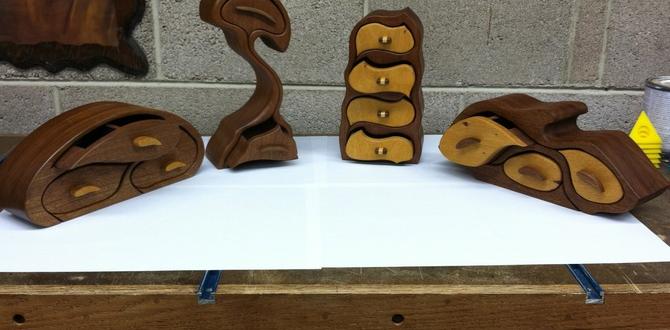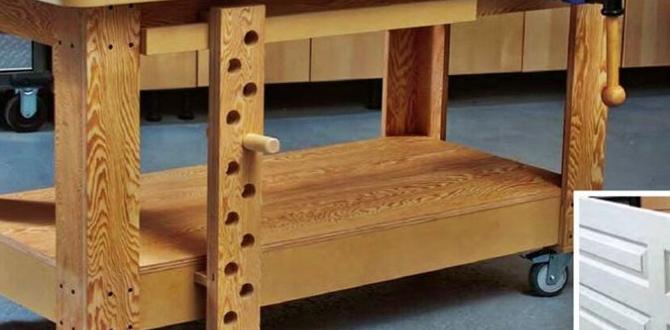Quick Summary: Loading nails into your nailer is simple! Just open the magazine, insert the correct size and type of nails with the tips facing the right way, and close the magazine until it clicks. Always ensure your nailer is off and unloaded for safety.
Hey there, DIY enthusiasts! Jack Shaffer here, your go-to guy for all things nailing and building. Ever found yourself staring at a brand-new nailer, ready to tackle that trim project or build that birdhouse, only to hit a snag before you even start? The most common stumble? Figuring out how to load those tiny nails correctly. It sounds basic, but a small mistake can lead to jams, damaged tools, or even a frustrating start to your project. Don’t let it get you down! In this guide, we’ll walk through loading nails into your nailer, step-by-step. We’ll make sure you’re confident and ready to power through your projects with ease. Let’s get those nails loaded and your project moving!
Table of Contents
Why Loading Nails Correctly Matters
It might seem like a small detail, but how you load nails into your nailer is actually pretty important. Getting it right means your nailer will work smoothly and efficiently. This is key, whether you’re a seasoned pro or just starting out on your first DIY adventure. When nails are loaded incorrectly, it can cause all sorts of problems. You might get jams, which are super annoying and can even damage your tool if you try to force things. Sometimes, the nails might not drive in straight, ruining your workpiece. By learning the proper way, you save yourself time, frustration, and potential repair costs. Plus, a well-loaded nailer makes your work look a whole lot better!
Understanding Your Nailer’s Magazine
Every nailer has a part called the magazine. This is where you put the nails! Think of it like the clip on a camera for film, but for nails. The magazine is designed to hold a specific type and size of nail and feed them smoothly into the nailing mechanism. Most nailer magazines open up, allowing you to load the nails. They usually have a spring-loaded follower that pushes the nails forward. Some might have a release lever or button to help you open it up. Knowing your specific nailer’s magazine is the first step to successful loading.
Types of Nail Magazines
Nailer magazines can vary a bit depending on the type of nailer you have. Here’s a quick rundown:
- Sequential or Contact Fire Nailers: These often have a slender, elongated magazine that feeds nails one at a time.
- Brad Nailers: Typically have a slim magazine good for small nails.
- Finish Nailers: Similar to brad nailers but usually for slightly larger nails, with a magazine that’s a bit wider.
- Framing Nailers: These have the largest magazines to hold many nails for heavier-duty construction.
- Staplers: While not nailers, they have a similar magazine for staples.
The mechanics are generally the same: open the magazine, load the fasteners, and close it. We’ll focus on nailers for this guide, but the principles are very similar for staplers too.
Choosing the Right Nails for Your Nailer
This is super important! Using the wrong nails is a surefire way to cause jams and damage. Nailers are designed for specific types and sizes of nails. Check your nailer’s manual or look for markings on the tool itself.
Common Nail Types and Sizes
Let’s break down some common nailer types and the nails they use:
| Nailer Type | Common Nail Size (Gauge) | Common Nail Size (Length) | Typical Use |
|---|---|---|---|
| Brad Nailer | 18 Gauge (thin) | 5/8″ to 2″ | Trim, decorative molding, small craft projects |
| Finish Nailer | 16 Gauge (medium) | 3/4″ to 2 1/2″ | Wainscoting, door and window casing, chair rails |
| Pin Nailer | 23 Gauge (very thin, headless) | 1/2″ to 1 1/4″ | Invisible fastening, delicate trim, picture framing |
| Framing Nailer | 8-12 Gauge (thick like traditional nails) | 2″ to 3 1/2″ | Framing walls, decks, rough carpentry |
Always match the nail gauge and length to what your specific nailer is designed for. Using nails that are too long might poke through the other side of your material, and nails that are too short won’t hold well. Using the wrong gauge can cause jams or be too flimsy to do the job. You can usually buy nails in packs at your local hardware store or online. Look for the gauge and length information clearly marked on the package.
Safety First: Before You Load
Before you even think about grabbing nails, safety is number one. Power tools can be dangerous if not handled properly. Here’s what you need to do before loading any nailer:
- Unplug or Remove Battery: For electric or battery-powered nailers, this means unplugging the power cord or removing the battery pack.
- Disconnect Air Hose: If you have an air-powered (pneumatic) nailer, always disconnect the air hose from the compressor.
- Point Away from Yourself and Others: Never point the nose of the nailer at yourself or anyone else, even when it’s not loaded or powered.
- Read Your Manual: Every tool is a little different. Your nailer’s manual is your best friend for specific details and safety warnings.
Taking these simple precautions prevents accidental firing and keeps everyone safe. It’s a habit that’s worth building from day one.
How to Load Nails into Your Nailer: Step-by-Step
Alright, let’s get down to business! Loading nails is a straightforward process once you know the steps. We’ll cover the most common types of nailer magazines here. Most nailers use a spring-loaded follower system.
Step 1: Prepare Your Nailer
As we just discussed, ensure your nailer is completely de-energized. For electric or battery models, unplug them or remove the battery. For pneumatic nailers, disconnect the air hose. This is the most critical safety step.
Step 2: Locate and Open the Magazine
The magazine is usually a long, rectangular component attached to the front of the nailer. You’ll need to slide or lift a part of it to open it.
- Sliding Mechanism: On many models, you’ll see a part of the magazine that can slide backward. There might be a button or lever to press to release it, or you might just need to pull it firmly. This reveals the nail channel.
- Hinged Mechanism: Some magazines might be hinged. Look for a latch or button that allows one side of the magazine to swing open.
Refer to your nailer’s manual if you’re unsure how your specific model opens. Always be gentle but firm; you don’t want to force anything.
Step 3: Load the Nails
Once the magazine is open, you’ll see a track or channel where the nails sit. Most nailers load with the nails pointing forward, towards the nose of the gun.
- Orientation is Key: For most brad and finish nailers, the nails load in a strip, with the heads facing upwards or downwards, depending on the design, against the magazine wall. The important part is that the shank of the nail is aligned with the channel. For framing nails, they might be collated at an angle, and you load the entire strip. Always check which way your specific nailer requires the nails to be loaded. Often, there’s a ruler or indicator on the magazine showing the correct nail size.
- Use the Correct Nails: Make sure you’re using the exact type and size of nails specified for your nailer.
- Place the First Nail: Insert the first nail into the channel, ensuring it sits snugly.
- Load the Strips: If your nails come in strips (which most do for brad and finish nailers), carefully place the entire strip into the channel. Ensure the first nail is seated correctly against the feed mechanism.
Don’t overfill the magazine. Load only as many nails as the magazine comfortably holds, usually one full strip or pack.
Step 4: Engage the Spring-Loaded Follower
There’s a spring-loaded piece, called a follower, inside the magazine. This follower pushes the nails forward so they can be fed into the firing chamber.
- Push the Follower: After loading the nails, you’ll need to push the follower back to compress the spring. This allows the magazine piece you opened in Step 2 to slide or close back into place.
- Smooth Operation: As you push the magazine closed, the follower should smoothly push the nails forward. You’ll feel some resistance from the spring.
If the nails get stuck or don’t move freely as you close the magazine, readjust them. A common mistake is having a nail at an angle, preventing the follower from moving correctly.
Step 5: Close the Magazine Securely
Once the nails are loaded and the follower is engaged, firmly close the magazine. You should hear or feel a click as it locks into place. Ensure it’s fully closed and secure before proceeding.
Step 6: Re-engage Power (Carefully!)
Now that the nails are loaded and the magazine is secure, you can reconnect the air hose, plug in the power cord, or reinsert the battery. Always keep the nose of the nailer pointed away from yourself and others!
And that’s it! Your nailer is loaded and ready to fire. It’s a simple sequence, but paying attention to each step makes all the difference for a smooth operation.
Troubleshooting Common Loading Issues
Even with the best intentions, you might run into a hiccup. Here are a few common problems and how to fix them:
- Nails Not Feeding:
- Cause: Follower not engaged properly, debris in the magazine, wrong nail type, or nail strip bent.
- Solution: Open the magazine, check for obstructions, ensure the follower is pushing the nails forward, and use the correct nails. Reload the strip carefully.
- Nails Jamming Immediately:
- Cause: Nails are at an angle or not seated correctly in the magazine.
- Solution: Unload the nails, realign them in the magazine, and try loading again. Make sure the first nail is straight in the channel.
- Magazine Won’t Close:
- Cause: Nails are overfilled, or the follower isn’t fully compressed.
- Solution: Remove some nails or ensure the follower is pushed back as far as it can go before closing the magazine.
- Nailer Fires but No Nail Comes Out:
- Cause: Could be a jam deeper in the mechanism, not necessarily a loading issue, but sometimes related to how the first nail was seated.
- Solution: Safely de-energize the tool. Check the nose of the nailer for any visible jams. You may need to consult your manual for clearing more complex jams.
Remember to always consult your tool’s manual if you’re unsure about a specific problem.
Best Practices for Nailer Maintenance
Keeping your nailer in good shape helps prevent loading issues and ensures it lasts for years. A little bit of care goes a long way!
Regular Cleaning
Dust and wood debris can build up inside the magazine and mechanism. After each project, or at least monthly, wipe down the exterior and interior of the magazine. You can use a clean, dry cloth. For deeper cleaning, a blast of compressed air can help dislodge debris, but avoid using lubricants inside the magazine unless specified by the manufacturer.
Lubrication (Pneumatic Nailers)
Pneumatic nailers often require a few drops of specialized air tool oil in the air inlet before each use. This keeps the internal components moving smoothly and prevents rust. Electric and battery nailers usually do not require user lubrication.
Proper Storage
Store your nailer in a clean, dry place. If possible, use its original case. This protects it from dust, moisture, and accidental damage. Ensure the magazine is empty before long-term storage.
Using the Right Nails
As we’ve stressed, using the correct collation (how the nails are held together in the strip) and type of nails is crucial. Incorrect collation can wear out the magazine and feeding mechanisms prematurely.
Hooking Up Air Tools Safely
For pneumatic nailers, ensure your air compressor is set to the correct PSI (pounds per square inch) recommended by your nailer’s manual. Consistent and correct air pressure is vital for performance and tool longevity. Also, use quality hoses and couplings. According to the Occupational Safety and Health Administration (OSHA), proper maintenance and use of pneumatic equipment, including understanding pressure requirements, are key to workplace safety.
Nailer Loading FAQs
Q1: Do I need to lubricate my nailer before loading nails?
For pneumatic (air-powered) nailers, it’s recommended to add a few drops of air tool oil to the air inlet before each use or at least daily. This keeps the internal parts working smoothly. Electric or battery-powered nailers typically don’t require user lubrication inside the mechanism.
Q2: Can I use any brand of nails in my nailer?
It’s best to use nails specifically designed for your nailer’s brand and model, or nails that meet the exact specifications (gauge, length, collation type) for your tool. Using incompatible nails is a common cause of jams and tool damage.
Q3: How many nails should I load at a time?
Load as many nails as the magazine is designed to hold, usually one full stick or strip. Overfilling can cause jamming and damage the spring or follower.
Q4: What does “gauge” mean for nails?
Gauge refers to the thickness of the nail shank or shaft. A lower gauge number means a thicker nail (e.g., 16-gauge is thicker than 18-gauge). Your nailer is designed for a specific gauge range.
Q5: My nails are jamming; is it always because I loaded them wrong?
While incorrect loading is a common culprit, jams can also be caused by debris in the magazine, bent nails, or internal tool issues. First, check your loading technique. If the problem persists, check for debris or damaged nails, and consult your tool’s manual.
Q6: How do I know which way the nails should face in the magazine?
Your nailer’s magazine usually has guide marks or a visual cue. For most brad and finish nailers, the nails load in a strip with the heads against one side of the magazine. Look for markings on the magazine or consult your manual for the correct orientation.
Conclusion
There you have it! Loading nails into your nailer is a fundamental skill that opens up a world of DIY projects. By understanding your tool, choosing the right nails, and following these simple, safe steps, you’ll be well on your way to confident and successful projects. Remember, a little attention to detail during the loading process saves a lot of headaches down the line. Master this, and you’re ready to tackle trim work, build that bookshelf, or start any project that calls for precise and quick fastening. Happy building!



